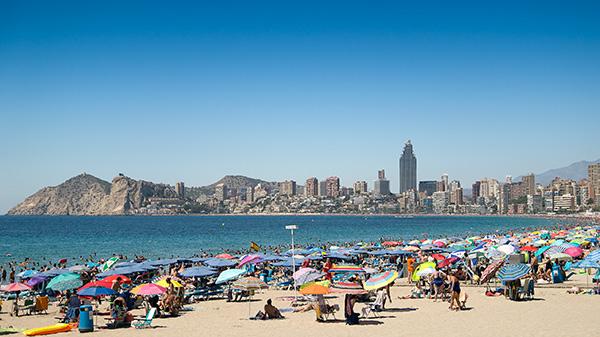
Egypt, Tunisia and Turkey’s loss of tourists, because of political violence and security concerns, has been partly Spain’s gain, helping the country to notch up another record year in arrivals.
As a result of a bumper July, with 9.6 million tourists (+9.1% year-on-year), the total number for 2016 will be more than 70 million, up from 68.2 million in 2015 (see Figure 1).

Brits, Germans and the French led the influx of tourists. Contrary to predictions, the weakening of sterling against the euro, following the UK’s decision on 23 June to leave the European Union, did not dent the number of British tourists, although by then bookings had been made. Their number in July rose 11.4% year-on-year to 2.2 million, followed by the French (1.5 million; + 13.8%) and the Germans (1.27 million; +3.5%).
July was such a good month, with hotels and restaurants full, particularly on the costas, that the number of tourists outstripped those in August 2015 (August is traditionally the best month).
A total of 42.4 million tourists came to Spain in the first seven months, 11.1% more than in the same period of 2015. This number for just over half a year was higher than the annual figure in the 1990s, underscoring how tourism has never ceased growing.
The labour intensive sector generates around 14% of GDP, making it the main driver of the economy and of job creation. Some 50,000 of the 84,000 jobs created in July were in tourism. The buoyant sector has played a key role in Spain’s emergence from a long period of recession and in the latest upward revision in the GDP growth forecast for this year (from 2.7% to 2.9%). The sector’s receipts have also helped to turn around the current account whose deficit reached close to 10% of GDP in 2007 (forecasted surplus of around 1.3% this year, similar to 2015).
Prices have remained competitive, although this writer was surprised to find in August that the price of a cup of coffee in Tuscany, one of Italy’s richest regions, was rarely more than €1 compared to €1.40 or more in Madrid, and pizzas are one half or two-thirds the price.
Yet the unemployment rate is still 20%, down from a peak of 27% in 2012, and more than 2 million have been out of work for more than two years. Tourism is a seasonal sector; many of the jobs are temporary. The Canary Islands, for example, received 13 million tourists in 2015 (six times the population and revenues contributed 30% of GDP), but the jobless rate is still astronomically high at 27%.
The record number of tourists is coming with a price, however. Fernando Clavijo, the president of the Canary Islands, has spoken of the need to put a cap on the number in order to avoid them becoming ‘another Magaluf’, the holiday resort in Majorca that has a dreadful reputation for noise, drunkenness and loutish behaviour.
Ada Colau, the mayor of Barcelona, is cracking down on home rental websites for tourists such as Airbnb, which are blamed for driving up the prices of flats and putting them beyond the reach of local residents. Residents of La Barceloneta, a working-class neighbourhood next to the beach, hold regular demonstrations to protest against the growing pressure from tourism. Berlin banned as of May the renting of flats to tourists and now only allows the letting of rooms if the owner lives in the property.
The Barcelona Town hall fined Airbnb €30,000 in August for advertising illegal flats which allegedly did not comply with local rules. Airbnb is appealing.
Barcelona (population 1.6 million) has seen a stratospheric increase in tourists since it held the Olympic Games in 1992 and became one of Europe’s most fashionable cities. The number of tourists – ranging from cruise ship visitors to weekend hen parties and the culturally minded on the trail of Picasso paintings or the buildings of Gaudi – rose from 1.7 million in 1990 to around 9 million in 2015.
Best known for its beaches, it tends to be forgotten that Spain has 44 UNESCO-declared World Heritage Sites, the most of any country after Italy and despite being a late joiner in 1984. The list is wide and testimony to Spain’s situation as a cradle of different cultures and civilisations. It takes in almost the entire history and geography of Spain, including Atapuerca near Burgos, where archaeologists discovered human bones in the late 1990s that date back 800,000 years, the Roman aqueduct in Segovia, the Alhambra Islamic palace in Granada and the Route of Santiago de Compostela, along which pilgrims began to walk in the Middle Ages to the city’s cathedral in Galicia where tradition has it that the remains of the apostle St. James are buried.
One of the many challenges for the new government whenever there is one – two inconclusive elections since last December have created gridlock in the political system – will be to find ways to attract more tourists away from the beaches and overcrowded cities like Barcelona, and so not kill the goose that lays the golden egg. It is a tall order.


